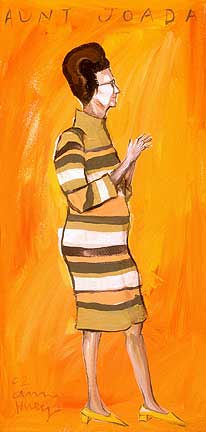 Ann Huey: 1967
Ann Huey: 1967
Women and Their Work
Austin, Texas
2003
As I sat down to write this, with images of Ann Huey’s seriocomic portrait series, 1967, spread out before me, I inexplicably found myself humming the theme from the 60s sitcom, I Dream of Jeannie.
At first, I thought it was Ann’s graphic, caricatural style that was triggering flashbacks to the opening titles of such shows. (The style of the day for signature openings to programs of the genre — “Bewitched” and “My Three Sons,” for instance — seemed to have been borrowed from a Hanna Barbara cartoon: the very two-dimensional heroes isolated in a limbo backdrop of tempera wash.)
For it’s a similar set in which Ann’s family and friends now find themselves. Look at the hip, minimalist environment where Fred Flintstone’s pet dinosaur, Dino, sprints (to a bongo riff) across a Mies van der Rohe living room apparently as long as a football field. Very much like it is the place where now stand (or sit) Grandma Zula, Uncle Weldon and her mom’s best friend, Emma Jane.
But the late 60’s zeitgeist is evoked by more than just a rendering style after “The Jetsons.” Ann’s subjects are perfectly cast. Like alien abductions, she has lifted her specimens directly out of their family photos because they so look like 1967. In hair, dress or facial expression, they’re archetypes. And I don’t know about you, but I know the type. They’re regular folk: kind, unassuming, and for the most part, comfortable in the skinny ties, sweater dresses and big hair then in style (or perhaps a little out of it). Boy, are they in for a shock.
Because, unbeknownst to them, in the next moment tectonic plates will slip and cultural seismographs will register big changes. I don’t remember 1967 so much for what happened as much as for what happened next. Martin Luther King and Bobby Kennedy both died at the hands of assassins, King on my birthday and Kennedy two months later on my sister’s. My blue-collar cousins in Cleveland started getting drafted and shipped off to Vietnam, and an hour north of my hometown of East Liverpool there would soon be four dead in O-hio.
After all that, it would get much harder for bubbly optimists (Pamela 1967) to keep up a front, and I can imagine even Ann’s cool, collected sister (Jane — the Recital) dropping her little white sweater and raising one clenched fist in protest.
Meanwhile, back at the ranch, Ann’s acrylic portraits of Texans we’ve all met, married, descend from or are otherwise related to are so dead-on because her subjects are vulnerable and somewhat at ease, apparently photographed by a friend or family member.
We know that we know Ann’s family friend (Dee 1967), smiling auntie (Aunt Winnie 1967) and the artist herself (Ann 1969) because they allowed their snapshooter to capture the imperfection of their humanity and because Ann has, in turn, relayed it with humor and affection.
But she’s also captured a milieu, and what sticks most with me is the sociological record, the documentation of a tribe at a critical moment in time. Like Richard Avedon’s series In the American West, or even Van Gogh’s portraits of desperate peasants and prostitutes, her studies are true to life and might belong on the shelf alongside the anthropological research of Margaret Mead.
My daughter, also an artist, did not exist in 1967, so she might not understand why I see historical significance or even irony in the cheerful expectancy of these portraits. She may, however, someday paint her own series, to remember what people looked like before everything changed in her world. And she might entitle hers, “September 10.”